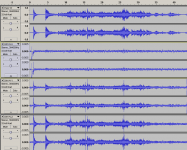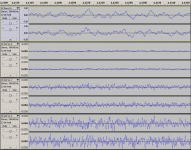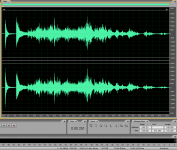...
What I did NOT know about the RA909 (911) was that many individual samples had very high crossover distortion. Yet others were pretty good...
How come? What process is/was responsible for this in monolytic design?
Thanks for the files, Karl, I'll start having a poke around.
In the meantime, here is a genuine glitch in the original LT2 files - B and D differ obviously - that I'm looking at. Both DiffMaker and Audacity picked it up, and it's occurring at the peak of one of the highest amplitude swings - what's the likely culprit?
View attachment 446850
I don't know Frank. B and D were in the unloaded condition and so it seems unlikely to be a something happening at the opamp (compression or limiting).
Would probably have to suggest its something occurring in the recording and sampling process although I wouldn't like to say what. A random glitch or the pc buffering or doing something else for an instant and causing a delay or something would be remarkable if it occurred at that peak. No answer on that I'm, afraid.
Yes, the adds are even more fun. I spent some time doing research today trying to find out where the open-loop BW stuff came from. Seems that Greiner published this idea back in 1964 and Otala took it up. Burwen of course was always "can't have enough feedback". 😀
Since I know Dick and Bob maybe a clarification "from over the years of experience" could appear in Linear Audio.
Scott that would be very nice! Maybe you can connect me to Greiner - Dick of course is already an L|A author.
Jan
That's what I said, I think the IDEA is wrong. BTW they published a IEEE version of their amplifier .6A of class A bias pretty extreme, and the VAS was loaded by 1.1K to a gain of only 11. 🙄
Yet, over the years, I have come to the conclusion that wide open loop bandwidth amps, with reduced levels of global feedback and more local NFB, tend to sound better than their standard counterparts. Not by default of course, but in general.
At first, I thought topology could be the reason for that, but again, over the years, I saw Harman/Kardon for example use just about any topology we can think of (I can supply a variety of servce schematics to back that up), from the classic single diff input stage to fully complementary, and the only consistent link was a wide OLB and low feedback. They usually tended to sound better than their direct competitors, although some did fall short.
How would you explain that?
Others also went that way as well, such as, for example, Metaxas Audio of Australia. Also very good sounding, easy, detailed, sort of open, so to speak.
Ultimately, the Otala/Lohstroh amp did, and still does, sound way better than one would expect just by looking at it, and its later day almost copies (e.g. some Pioneer Exclusive series appear to be replicas on sterioids).
Last edited:
Dejan, my preamp ( Dispre 2 - JFET english ) has loopgain (feedback) of 71dB at low frequencies, OLG corner at 2.4kHz and it still has 58.5dB feedback at 10kHz. I thought, long ago, that low global feedback is a key to a good sounding circuit, but I really do not keep such opinion anymore. The circuit is very fast, with high slew rate and very low distortion.
Okay, first comparisons are in on those 4 passes of recording using the same circuitry, by Karl, and, some verrry interesting results - first the bad news: the files aren't identical, not by a long shot; but, there is a pattern ...
To make things interesting, I set one pass as the reference, called it W, and generated the diff files between that and the rest, and this is what I got:

Note the sample rate, I had to oversample to this level to get clean synch'ng. Just in case one might think that the higher amplitude files are due to gain matching issues, I zoomed in at the 4.4 secs mark:

So, what guesses, etc, as to which passes W, X, Y and Z are? And what might be going on?
To make things interesting, I set one pass as the reference, called it W, and generated the diff files between that and the rest, and this is what I got:

Note the sample rate, I had to oversample to this level to get clean synch'ng. Just in case one might think that the higher amplitude files are due to gain matching issues, I zoomed in at the 4.4 secs mark:

So, what guesses, etc, as to which passes W, X, Y and Z are? And what might be going on?
I agree. What seems obvious, for me, is: As far as the response curve of an amp, closed loop, at the input of his VAS, will not be flat up to 20KHz, i will not be fully satisfied for audio.Yet, over the years, I have come to the conclusion that wide open loop bandwidth amps, with reduced levels of global feedback and more local NFB, tend to sound better than their standard counterparts. Not by default of course, but in general.
I prefer less feedback (so less open-loop gain) if it can satisfy better this condition.
That is great Frank, thanks for doing that, and its great because it proves that the method used to produce the files is perhaps fallible, not perfect. And that is to be expected given that the equipment (PC, ADC etc) used is non audio based.
So where does that leave things and why is that a good thing ? Well I think because it throws emphasis back on the subjective nature of the tests and that they are really designed to be listened too. A random difference shouldn't greatly detract from the overall listening experience in the way that test driving two cars over an identical route wouldn't be swayed by one drive runing over a pothole and the other not. Its the overall impression that counts.
Those four files were produced in sequence as follows.
1/ Open Audacity
2/ Hit play on the Marantz
3/ Hit record on Audacity
4/ Save the project file and close Audacity.
Then repeat from start. No lead swapping or anything like that. Just four consecutive runs.
So either the Marantz is doing something different each run, or the PC is... or both.
The only way to nail that would be to run one player into four identical PC's all running together. That would give four different files from one playback run. And they should all be the same.
If you can match amplitudes I could do a .wav rip of the track to compare against. Would tat help ? One that hasn't been through a playback and record chain.
Interesting result 🙂
So where does that leave things and why is that a good thing ? Well I think because it throws emphasis back on the subjective nature of the tests and that they are really designed to be listened too. A random difference shouldn't greatly detract from the overall listening experience in the way that test driving two cars over an identical route wouldn't be swayed by one drive runing over a pothole and the other not. Its the overall impression that counts.
Those four files were produced in sequence as follows.
1/ Open Audacity
2/ Hit play on the Marantz
3/ Hit record on Audacity
4/ Save the project file and close Audacity.
Then repeat from start. No lead swapping or anything like that. Just four consecutive runs.
So either the Marantz is doing something different each run, or the PC is... or both.
The only way to nail that would be to run one player into four identical PC's all running together. That would give four different files from one playback run. And they should all be the same.
If you can match amplitudes I could do a .wav rip of the track to compare against. Would tat help ? One that hasn't been through a playback and record chain.
Interesting result 🙂
I agree. What seems obvious, for me, is: As far as the response curve of an amp, closed loop, at the input of his VAS, will not be flat up to 20KHz, i will not be fully satisfied for audio.
Assuming with 'response curve' do you mean the THD response, lets say we have these two cases:
case A; amp has -120dB THD at 100 Hz, rising to -80dB at 20kHz;
case B; amp has flat -80dB THD from 100Hz to 20kHz.
So you would prefer case B?
Jan
He might put the resistor to load the VAS to get the desired effect. The debate is close to useless.
If you can match amplitudes I could do a .wav rip of the track to compare against. Would tat help ? One that hasn't been through a playback and record chain.
Done anyway 🙂
Direct WAV
Indeed it would - in the meantime, you supplied recordings 1, 2, 3, 4 - done in that order I presume - any thoughts on how that might correspond to my W, X, Y, Z?If you can match amplitudes I could do a .wav rip of the track to compare against. Would tat help ? One that hasn't been through a playback and record chain.
Karl, thanks for whipping it through - I have some bad news straight away ... the playback/record path is clipping, at about the 0.8 amplitude level on the dropbox files it's flat topping ...
Karl, thanks for whipping it through - I have some bad news straight away ... the playback/record path is clipping,
Frank, this file? It is Karl's Direct wav.
Attachments
No, on the files that passed through the playback/record chain, there were 4 of them - the Direct wav is clean.
Plus, and this makes sense of course, the combination of clocks doesn't perfectly match the 44.1/48k ratio - the record chain is running slow by about 2 parts in 48,000.
Unfortunately, I was unable to find the links to the recorded files - this thread is so long and posts are in tens or hundreds a day 🙂
May I make my own run and files with loaded and unloaded preamplifier?
May I make my own run and files with loaded and unloaded preamplifier?
Last edited:
He might put the resistor to load the VAS to get the desired effect. The debate is close to useless.
I try to make the issue clear. Maybe I am the only one who really wants to know what the issue is?
BTW Just received a copy of Willy Sansen's book.
What a wealth of information!
Jan
Maybe I am the only one who really wants to know what the issue is?
Not the only one, definitely. I apologize for my irony.
Pavel, this links to the files, http://www.diyaudio.com/forums/loun...owtorch-preamplifier-part-ii.html#post4111105 - they are Audacity project files, not WAV, so you need to have that program onboard, to export the sound files.
- Status
- Not open for further replies.
- Home
- Member Areas
- The Lounge
- John Curl's Blowtorch preamplifier part II
